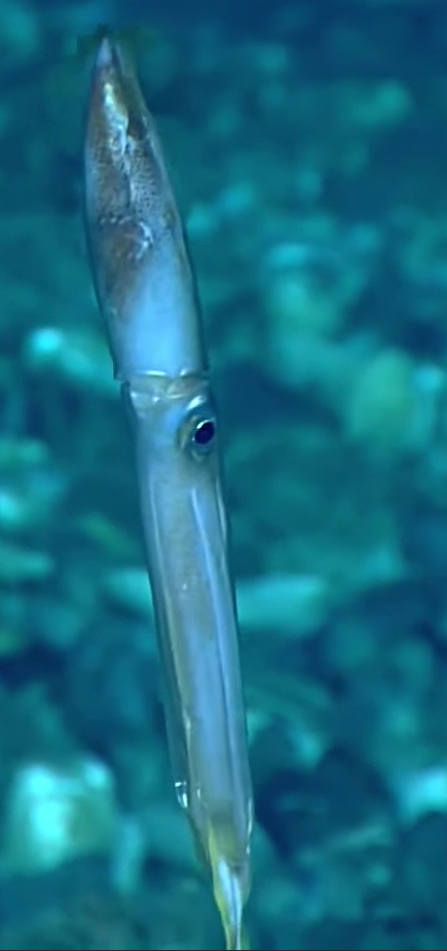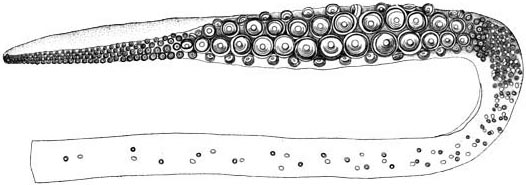|
Neoteuthidae
The Neoteuthidae are a family of squid comprising four monotypic genera. They are thought to be the closest relatives to the famous giant squid The giant squid (''Architeuthis dux'') is a species of deep-ocean dwelling squid in the family Architeuthidae. It can grow to a tremendous size, offering an example of abyssal gigantism: recent estimates put the maximum size at around Trac ... (''Architeuthis dux''). Species * '' Alluroteuthis'' ** '' Alluroteuthis antarcticus'', Antarctic neosquid * '' Narrowteuthis'' ** '' Narrowteuthis nesisi'' * '' Neoteuthis'' ** '' Neoteuthis thielei'' * '' Nototeuthis'' ** '' Nototeuthis dimegacotyle'' References External links Tree of Life web project: Neoteuthidae Architeuthoidea Cephalopod families Taxa named by Adolf Naef {{squid-stub ... [...More Info...] [...Related Items...] OR: [Wikipedia] [Google] [Baidu] |
Neoteuthidae
The Neoteuthidae are a family of squid comprising four monotypic genera. They are thought to be the closest relatives to the famous giant squid The giant squid (''Architeuthis dux'') is a species of deep-ocean dwelling squid in the family Architeuthidae. It can grow to a tremendous size, offering an example of abyssal gigantism: recent estimates put the maximum size at around Trac ... (''Architeuthis dux''). Species * '' Alluroteuthis'' ** '' Alluroteuthis antarcticus'', Antarctic neosquid * '' Narrowteuthis'' ** '' Narrowteuthis nesisi'' * '' Neoteuthis'' ** '' Neoteuthis thielei'' * '' Nototeuthis'' ** '' Nototeuthis dimegacotyle'' References External links Tree of Life web project: Neoteuthidae Architeuthoidea Cephalopod families Taxa named by Adolf Naef {{squid-stub ... [...More Info...] [...Related Items...] OR: [Wikipedia] [Google] [Baidu] |
Architeuthoidea
Architeuthoidea is a superfamily of squid in the order Oegopsida. It consists of only five monotypic genera in two different families: Architeuthidae, containing only the famous giant squid, and 4 species in their own genera in the family Neoteuthidae. * Superfamily Architeuthoidea ** Family Architeuthidae *** Genus '' Architeuthis'' ** Family Neoteuthidae *** Genus '' Alluroteuthis'' *** Genus '' Narrowteuthis'' *** Genus ''Neoteuthis ''Neoteuthis'' is a monotypic genus of squid, the sole member is ''Neoteuthis thielei'', from the family Neoteuthidae. This species has long tentacular clubs measuring 60% of the mantle length and fins which are 70% of its mantle length. It h ...'' *** Genus '' Nototeuthis'' References Oegopsida Mollusc superfamilies Taxa named by Samuel Stillman Berry {{Squid-stub ... [...More Info...] [...Related Items...] OR: [Wikipedia] [Google] [Baidu] |
Nototeuthis Dimegacotyle
''Nototeuthis'' is a monotypic genus of squid, in the family Neoteuthidae. The only species in this genus is ''Nototeuthis dimegacotyle ''. This species is characterised by short tentacular clubs, less than 40% of the length of the mantle, and relatively long fins, which are approximately 60% of the mantle length. The tentacle clubs have two greatly enlarged suckers on distal portion of the manus, which distinguish ''N. dimegacotyle'' from other members of the Neoteuthidae. Few specimens of this species are currently known. Specimens have been collected from the south eastern Pacific Ocean, off Chile, between the Southern Subtropical and the Antarctic Polar frontal zones. This species is mesopelagic to bathypelagic The bathypelagic zone or bathyal zone (from Greek βαθύς (bathýs), deep) is the part of the open ocean that extends from a depth of below the ocean surface. It lies between the mesopelagic above, and the abyssopelagic below. The bathypelagic ... and can be f ... [...More Info...] [...Related Items...] OR: [Wikipedia] [Google] [Baidu] |
Nototeuthis
''Nototeuthis'' is a monotypic genus of squid, in the family Neoteuthidae. The only species in this genus is ''Nototeuthis dimegacotyle ''. This species is characterised by short tentacular clubs, less than 40% of the length of the mantle, and relatively long fins, which are approximately 60% of the mantle length. The tentacle clubs have two greatly enlarged suckers on distal portion of the manus, which distinguish ''N. dimegacotyle'' from other members of the Neoteuthidae. Few specimens of this species are currently known. Specimens have been collected from the south eastern Pacific Ocean, off Chile, between the Southern Subtropical and the Antarctic Polar frontal zones. This species is mesopelagic to bathypelagic The bathypelagic zone or bathyal zone (from Greek βαθύς (bathýs), deep) is the part of the open ocean that extends from a depth of below the ocean surface. It lies between the mesopelagic above, and the abyssopelagic below. The bathypelagic ... and can be f ... [...More Info...] [...Related Items...] OR: [Wikipedia] [Google] [Baidu] |
Narrowteuthis
''Narrowteuthis'' is a monotypic genus of squid, the sole member is ''Narrowteuthis nesisi'', from the family Neoteuthidae. It is known from just two specimens caught off the Canary Islands The Canary Islands (; es, Canarias, ), also known informally as the Canaries, are a Spanish autonomous community and archipelago in the Atlantic Ocean, in Macaronesia. At their closest point to the African mainland, they are west of Morocc ... at 27°18'N, 19°44'W. References {{Taxonbar, from=Q18580791 Neoteuthidae Molluscs described in 2005 Monotypic mollusc genera Fauna of the Canary Islands ... [...More Info...] [...Related Items...] OR: [Wikipedia] [Google] [Baidu] |
Neoteuthis
''Neoteuthis'' is a monotypic genus of squid, the sole member is ''Neoteuthis thielei'', from the family Neoteuthidae. This species has long tentacular clubs measuring 60% of the mantle length and fins which are 70% of its mantle length. It has a proximal locking-apparatus for the club which is restricted to manus, which in turn has proximal suckers which are circular. It has been recorded from the South Atlantic Ocean, North Atlantic Ocean, near the Canary Islands and North Pacific Ocean, north of Hawaii. The paralarvae and juveniles are found in the epipelagic to mesopelagic zones while adults occur in the mesopelagic to bathypelagic The bathypelagic zone or bathyal zone (from Greek βαθύς (bathýs), deep) is the part of the open ocean that extends from a depth of below the ocean surface. It lies between the mesopelagic above, and the abyssopelagic below. The bathypelagic ... zones. References Neoteuthidae Molluscs described in 1921 Monotypic mollusc genera ... [...More Info...] [...Related Items...] OR: [Wikipedia] [Google] [Baidu] |
Neoteuthis Thielei
''Neoteuthis'' is a monotypic genus of squid, the sole member is ''Neoteuthis thielei'', from the family Neoteuthidae. This species has long tentacular clubs measuring 60% of the mantle length and fins which are 70% of its mantle length. It has a proximal locking-apparatus for the club which is restricted to manus, which in turn has proximal suckers which are circular. It has been recorded from the South Atlantic Ocean, North Atlantic Ocean, near the Canary Islands and North Pacific Ocean, north of Hawaii. The paralarvae and juveniles are found in the epipelagic to mesopelagic zones while adults occur in the mesopelagic to bathypelagic The bathypelagic zone or bathyal zone (from Greek βαθύς (bathýs), deep) is the part of the open ocean that extends from a depth of below the ocean surface. It lies between the mesopelagic above, and the abyssopelagic below. The bathypelagic ... zones. References Neoteuthidae Molluscs described in 1921 Monotypic mollusc gener ... [...More Info...] [...Related Items...] OR: [Wikipedia] [Google] [Baidu] |
Narrowteuthis Nesisi
''Narrowteuthis'' is a monotypic genus of squid, the sole member is ''Narrowteuthis nesisi'', from the family Neoteuthidae. It is known from just two specimens caught off the Canary Islands The Canary Islands (; es, Canarias, ), also known informally as the Canaries, are a Spanish autonomous community and archipelago in the Atlantic Ocean, in Macaronesia. At their closest point to the African mainland, they are west of Morocc ... at 27°18'N, 19°44'W. References {{Taxonbar, from=Q18580791 Neoteuthidae Molluscs described in 2005 Monotypic mollusc genera Fauna of the Canary Islands ... [...More Info...] [...Related Items...] OR: [Wikipedia] [Google] [Baidu] |
Squid
True squid are molluscs with an elongated soft body, large eyes, eight arms, and two tentacles in the superorder Decapodiformes, though many other molluscs within the broader Neocoleoidea are also called squid despite not strictly fitting these criteria. Like all other cephalopods, squid have a distinct head, bilateral symmetry, and a mantle. They are mainly soft-bodied, like octopuses, but have a small internal skeleton in the form of a rod-like gladius (cephalopod), gladius or pen, made of chitin. Squid diverged from other cephalopods during the Jurassic and occupy a similar role to teleost fish as open water predators of similar size and behaviour. They play an important role in the open water food web. The two long tentacles are used to grab prey and the eight arms to hold and control it. The beak then cuts the food into suitable size chunks for swallowing. Squid are rapid swimmers, moving by Aquatic locomotion#Jet propulsion, jet propulsion, and largely locate their ... [...More Info...] [...Related Items...] OR: [Wikipedia] [Google] [Baidu] |
Giant Squid
The giant squid (''Architeuthis dux'') is a species of deep-ocean dwelling squid in the family Architeuthidae. It can grow to a tremendous size, offering an example of abyssal gigantism: recent estimates put the maximum size at around Tracey, D. M., O. F. Anderson & J. R. Naylor (2011)''A guide to common deepsea invertebrates in New Zealand waters. Third edition.''National Institute of Water and Atmospheric Research, Wellington. 317 pp.Yukhov, V. L. (2014)Гигантские кальмары рода ''Architeuthis'' в Южном океане / Giant calmaries ''Аrchiteuthis'' in the Southern ocean igantskiye kalmary roda ''Architeuthis'' v Yuzhnom okeane.''Ukrainian Antarctic Journal'' no. 13: 242–253. for females and for males, from the posterior fins to the tip of the two long tentacles (longer than the colossal squid at an estimated , but substantially lighter, due to the tentacles making up most of the length). The mantle of the giant squid is about long ... [...More Info...] [...Related Items...] OR: [Wikipedia] [Google] [Baidu] |
Alluroteuthis Antarcticus
The Antarctic neosquid (''Alluroteuthis antarcticus'') is the only neosquid in the genus ''Alluroteuthis''. The tentacles are relatively short compared to the arms. Nils Hjalmar Odhner, discoverer of the species, suggested that '' Parateuthis tunicata'', discovered by Johannes Thiele in 1920, might be a young Antarctic neosquid. The validity of this suggestion is still in question. The name is derived from its habitat in the Antarctic Ocean. Distribution ''Alluroteuthis antarcticus'' occurs in from depths of 0–2,800 m ( epipelagic and mesopelagic waters), and paralarvae can be found in the upper 200 m ( epipelagic waters). Its range may be circumpolar with an Antarctic and Sub-Antarctic distribution. Ecology It preys upon Antarctic krill Antarctic krill (''Euphausia superba'') is a species of krill found in the Antarctic waters of the Southern Ocean. It is a small, swimming crustacean that lives in large schools, called swarms, sometimes reaching densities ... [...More Info...] [...Related Items...] OR: [Wikipedia] [Google] [Baidu] |
Adolf Naef
Adolf Naef (1 May 1883 – 11 May 1949) was a Swiss zoologist and palaeontologist who worked on cephalopods and systematics. Although he struggled with academic politics throughout his career and difficult conditions during World War I and II, his work had lasting influences on the fields of phylogenetics, morphology, and embryology. Life Naef was born in Herisau, Switzerland, to parents Martin and Berta. In 1904, he began studying philosophy and literature at the University of Zurich, but soon switched to natural sciences. He graduated in 1908 and went on to pursue a PhD under the guidance of Arnold Lang (1855—1914), a former Professor of Jena University and close friend of Ernst Haeckel as well as a long-time associate of Anton Dohrn.Rieppel, Olivier (2016). ''Phylogenetic Systematics: Haeckel to Hennig.'' CRC Press. Naef visited Dohrn's Zoological Station in Naples, Italy in 1908. Although initially planning to collect eggs from a variety of animals, he ended up stu ... [...More Info...] [...Related Items...] OR: [Wikipedia] [Google] [Baidu] |


.jpg)

